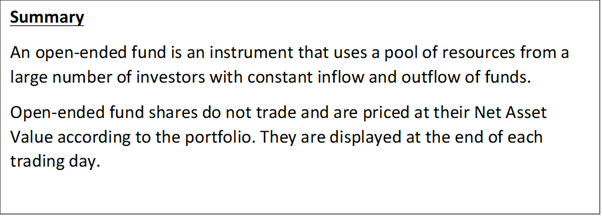What do you mean by Open-Ended Funds?
An open-end fund is an aggregate investment vehicle that can issue and redeem shares whenever you want. For the most part, a financial backer will buy shares in the asset directly from the fund instead of current investors. Open-ended funds are accessible in most evolved nations. However, the wording and working guidelines differ from country to country. US mutual funds, UK unit trusts and OEICs, European SICAVs, and hedge funds are a few basic examples of open-ended assets.
The price at what shares in an open-ended asset is given or recovered will differ with respect to the investment's net asset value, thus straightforwardly mirrors its performance.

Copyright © 2021 Kalkine Media
Understanding Open-Ended Funds
An open-end fund is a differentiated arrangement of pooled financial backer cash that can provide a limitless number of shares. The asset support sells share directly to financial backers and redeems them too. These shares are evaluated every day in light of their present net asset value (NAV). Some hedge funds, mutual funds, and exchange-traded funds (ETFs) are types of open-end reserves. These are more popular than close-ended funds and are the defence of the venture alternatives in the organisation-supported retirement plans, for example, a 401(k).

Copyright © 2021 Kalkine Media
An open-end fund issues shares as long as investors need them. Buying shares cause the asset to make new substitution shares while selling shares removes them from the course. Offers are purchased and sold on request at their net asset value. The regular schedule of the net asset value is on the worth of the asset's basic protections and is determined toward the finish of the exchanging day. If an enormous number of shares are recovered, the asset may sell some of its holdings to pay the selling financial backers.
An open-end fund gives financial backers a simple, minimal expense approach to pool cash and buys an expanded portfolio mirroring a particular speculation objective. The general aim of investing in these instruments is income or long-term capital appreciation in large-cap or small-cap companies with due diligence. Further, the assets can target interests into explicit enterprises or nations. Financial backers mainly don't require significant initial capital to buy shares of a fund, making it more accessible for retail investors.
The cash pooled by financial backers is overseen by a common asset chief who contributes as per the shared asset style. For instance, expect three financial backers to pool together US $600 and are given one share each. The US $600 is overseen by an asset director who puts the cash in instruments. If the cost of the protections duplicates throughout the following year, the net resource worth of the asset would be US $1200 (US $600 x 2). With every financial backer holding one offer, their per-share cost in the common asset would be $400 ($1200/3). Financial backers keen on joining the common asset can buy shares directly from the asset administrator at the net asset value per portion of US $400. Expect three new financial backers contribute US $1200 altogether. The new net resource worth would be $2400 ($1200 NAV + $1200 commitment), and the investors would be given three extra offers in the shared asset. With six extraordinary offers in the standard investment, the net resource esteem per share remains $400 ($2400/6).
Sporadically, when a funds portfolio management verifies that an asset's complete resources have gotten too enormous to even think about executing its expressed target adequately, the asset will be shut to new financial backers. In outrageous cases, a few finances will be closed to extra venture by existing asset investors.
Open-end funds usually are very similar to mutual funds, that numerous financial backers may not understand they are not by any means the only sort of asset around. This sort of speculation store is not even the first kind of venture reserve. Close-ended funds are way older than mutual fund by decades, dating from 1893 to the Closed-End Fund Center.
In an open-ended fund, financial backers buy portions of the shared asset at the net asset value. Thus, comprehension of net asset value is significant when discussing open-end joint investments. The cost per offer, or NAV, is determined by partitioning the assets subtracted by the liabilities by the number of offers traded. This is typically determined toward the finish of each exchanging day.
Some of the famous open-ended funds are:
- Fidelity’s Magellan Fund
- Rowe Price
- PIMCO Total Return
- The Vanguard Group’s S&P 500
Hedge Funds are also a type of open-ended funds which portfolio managers actively manage. The only difference is that investors do not have much flexibility in redeeming shares or withdrawing funds. Typically, there is a lock-in period, or the investors can save only once a month or less frequently.
Frequently Asked Questions
What are the pros and cons of Open-ended funds?
The pros of open-ended funds are:
- The unsystematic risk is diversified as main securities are held in the portfolio, which balances out the correlation and is a significant advantage.
- Expert portfolio managers and analysts usually manage open-ended funds.
- A low initial investment is required as it is a pool of resources where many investors look to invest.
- Open-ended funds are highly liquid, which means any investor can withdraw their funds when required at a fair price without a haircut.
- Investors have greater flexibility.
The cons of open-ended funds are:
- Open-ended funds have to maintain a high cash reserve ratio because there can be a distant possibility of many investors withdrawing their investments altogether.
- The fund charges a management fee, and many funds also charge an initial fee or front-end load and a close-end load charge.
- The returns of an open-ended fund are lower than a close-ended fund because of the large amount of cash held by the fund.
- The NAV is received at the end of the day. Due to this, any investor who trades during the business day will realise the profit or loss from the open-ended fund at the end of the day.
 Please wait processing your request...
Please wait processing your request...